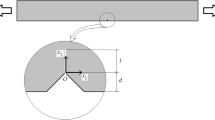Abstract
A new method is suggested aimed at evaluating \(\mathcal{G}\) IC , the mode I fracture energy of thin brittle layers. The fracture energy is obtained by cleaving a ceramic layer sandwiched between two metallic layers, joined by brazing. The driving force for the cleavage is the mismatch between the thermal expansion coefficients of the ceramic and the metallic layers. The fracture energy is calculated from the strain energy released in the cleaved sandwiched structure. Based on this method, the fracture energy of the ceramic layer can be evaluated if the cleavage temperature is known, either by visual inspection or instrumentation. The method is effective for thin ceramic layers, for the determination of the fracture energy of cleavage planes of single crystal brittle solids (provided the cleavage plane is within the plane of the specimen), and for the interfacial fracture energy of ceramic/ceramic or ceramic/metal joints. In order to verify and calibrate the test method, polycrystalline alumina thin plates were joined by brazing with Ti-6Al-4V alloy using Wesgo Cusil ABA alloy. The appropriate selection of materials and geometry, and some difficulties arising from this method are discussed.
Similar content being viewed by others
References
Bagchi, A., Lucas, G.E., Suo, Z. and Evans, A.G. (1994). A new procedure for measuring the decohesion energy for thin ductile films of substrates. Journal of Materials Research 9, 1734-41.
Becher, P.F. (1976). Fracture strength anisotropy. Journal of the American Ceramic Society 59, 59-61.
He, M.Y., Xu, G., Clarke, D.R., Ma, Q. and Fujimoto, H. (1997). The energy release rate for decohesion in thin multilayered films on substrates. Materials Resources Society of Symposium Proceedings 473, 15-20.
Ho, S., Hillman, C., Lange, F.F. and Suo, Z. (1995). Surface cracking in layers under biaxial residual compressive stresses. Journal of the American Ceramic Society 78, 2353-59.
Hutchinson, J.W. and Suo, Z. (1992). Mixed mode cracking in layered materials. Advances in Applied Mechanics 29, 63-189.
Lawn, B.R. and Fuller, E.R. (1975). Equilibrium penny-like cracks in indentation fracture. Journal of Materials Science 10, 2016-2024.
Metals Handbook (1975). 8th Edition, Vol. 1, American Society for Metals. 9.1-9.9.
Munz, D. (1983). Effect of specimen type on the measured values of fracture toughness of brittle ceramics. Fracture toughness of Ceramics 6, (Edited by R.C. Bradt, A.G. Evans, D.P.H. Hasselman and F.F. Lange) Plenum Press, New York.
Naka, M., Sahpath, K., Okamoto, I. and Arata, Y. (1988). Joining mechanisms of ceramic to metal using amorphous titanium-based filler metal. Materials Science and Engineering 98, 407-410.
Nishida, T., Hanaki, Y. and Pezzotti, G. (1994). Effect of notch-root radius on the fracture toughness of a finite-grained alumina. Journal of the American Ceramic Society 77, 606-608.
Nose, T. and Fujii, T. (1988). Evaluation of fracture toughness for ceramic materials by a single-edge precracked-beam method. Journal of the American Ceramic Society 71, 328-333.
Sadahiro, T. and Takatsu, S. (1981). A new precracking method for fracture toughness testing of cemented carbides. Modern Developments in Powder Metallurgy 14, (Edited by H.H. Hauser, H.W. Antes and G.D. Smith). Metal Powder Industries Federation, Princeton, NJ. 561-572.
Sherman, D. (1995). Unpublished results.
Sherman, D. (1997). Fracture toughness evaluation of small thin ceramic specimens. Journal of the American Ceramic Society 80, 1904-1906.
Sherman, D. (1998). The mechanical behavior of brazed metal/ceramic multilayers. Materials Letters 33, 255-260.
Timoshenko, S. (1925). Analysis of bi-metal thermostats. Journal of the Optical Society of America 11, 233-255.
Tvergaard, V. and Hutchinson, J.W. (1994). Toughness of an interface along a thin ductile layer joining elastic solids. Philosophic Magazine A70, 641-650.
Warren, R. and Johnson, B. (1984). Creation of stable cracks in hard metals using ‘bridge’ indentation. Powder Metallurgy 27, 25-29.
Wiederhorn, S.M. (1969). Fracture of sapphire. Journal of the American Ceramic Society 52, 485-491.
Author information
Authors and Affiliations
Rights and permissions
About this article
Cite this article
Sherman, D., Rahav, S. A note on evaluating the fracture energy of thin ceramic layers by cleavage. International Journal of Fracture 99, 189–199 (1999). https://doi.org/10.1023/A:1018669709452
Issue Date:
DOI: https://doi.org/10.1023/A:1018669709452




